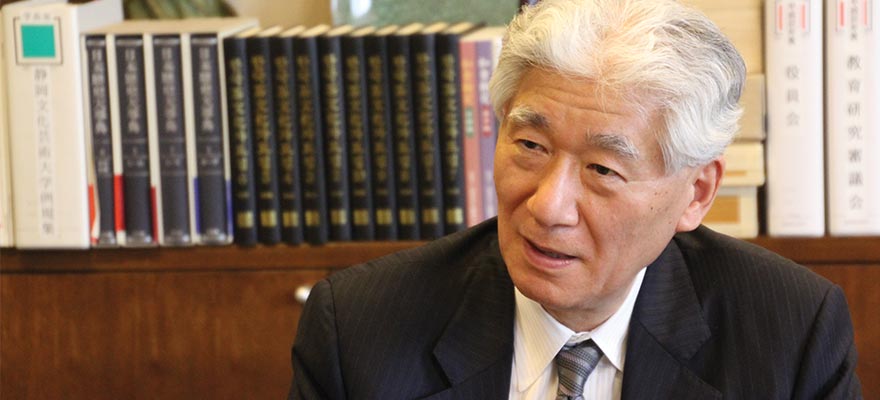Home > Highlighting JAPAN >Highlighting Japan July 2014>Summer in Japan
Highlighting JAPAN
Summer in Japan
An Interview with Isao Kumakura
The Many Ways to Enjoy Japan's Sizzling Summers

Japan 's summertime sometimes seems to be the least loved of all the seasons, as scorching temperatures combined with high humidity apparently make summer less than comfortable for many people. Even well into Japan's past, Japanese people regarded summer as a difficult time, says Isao Kumakura, president of the Shizuoka University of Art and Culture and an authority on Japanese cultural history. Kumakura described the various ways Japanese people discovered how to spend a sizzling summer in relative comfort, including building designs, food, events such as festivals and distinctive customs.
Perhaps the most obvious impact of steamy summers can be found in traditional Japanese architecture. As Kenko Yoshida, one of Japan's three greatest essayists, said in his work "Tsurezuregusa": "Japanese houses should be built with the summer season in mind." Kumakura notes that Japanese buildings and homes, particularly those in the southern part of Japan, were specifically designed to ventilate summer heat. Japanese houses tended to be thin-walled wooden structures that used sliding doors called shoji to partition the rooms. Removing the shoji permitted air to circulate freely throughout the structure. In addition, to allow the breezes in while keeping the inevitable mosquitoes out, mosquito nets called kaya made of coarse hemp cloth were hung up in the rooms.
Outside, people would sprinkle water in their gardens and on the unpaved roads, which both reduced dust and prompted evaporation to cool the air. However, Kumakura explains, this action also served to cleanse and purify the surrounding area. This was often done for religious motives as well as out of respect for customers, and is a custom still seen today.
Summer influenced adaptations to diets as well, involving seasonal fare with lighter, more refreshing tastes. According to Kumakura, both the light taste of vinegared dishes as well as rich, flavorful foods are popular in the summer, the latter partly because eating rich food helps stave off heat fatigue. He recounted one example of how Kyoto residents like to eat fatty hamo. Hamo is a hardy Japanese conger eel that could survive the long, waterless journey from the Seto Inland Sea to the ancient capital and be eaten fresh, even in the summer season. Chefs carefully chop the hamo's meat and numerous tiny bones a mere millimeter apart without breaking through the skin. The now-edible bones and white flesh are carefully shaped and served with a dollop of sour red plum paste, giving the appearance of a beautiful white peony flower. The white eel flesh looks cool, and the refreshing bite of the plum paste perks people up.
Naturally summer exacts a physical toll on the body as well. For that reason, Kumakura says, there are unique ceremonies such as summer festivals in which Japanese seek spiritual protection to help them survive the summer months. For example, in one ritual held all over Japan on June 30 called nagoshi-no-harae, a two-meter-tall circular loop of reeds known as a chinowa is placed in front of certain Shinto shrines. Passing through the loop symbolizes a baby's birth, and thus people become purified and 'reborn' for the ensuing year to come.
Careful attention to summer's sights and sounds also helped transform the stifling months into a delight for the senses. Japanese gave specific names to the multitude of summer insects, Kumakura says, allowing them to distinctly experience the passage of summer by heeding the changing sounds. The tinkling of wind chimes, for example, could help one feel cooler just by recognizing that a breeze was flowing by.
The end result of preparing homes to adapt to summer, eating seasonal foods and participating in special rituals and festivals was that "summer itself became something to look forward to," Kumakura notes. True as much for ancient Japan as now, summer can become an enjoyable season—with the right attitude.
Celebrating Obon
For Japanese people, summer is a special time of year because it is the season of obon. During obon, the spirits of ancestors are said to return from the afterlife to visit their homes and pass the time with their families. At the beginning of obon a small fire is lit to welcome these spirits, and at obon's end, people light the fire again to usher the spirits back to the afterlife. This memorial celebration for the dead has been conducted since ancient times. In summer, events that use fire and fireworks are common because fire represents a memorial for the deceased. And the Bon dance—once originally performed to welcome and express gratitude to the spirits for coming—and the memorial services to appeal to the spirits of ancestors to fend off plagues and natural disasters are now done throughout Japan. The dance spices up these modern summer festivals.
© 2009 Cabinet Office, Government of Japan






